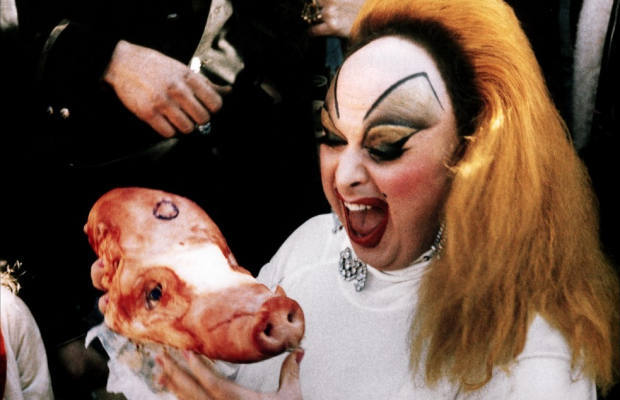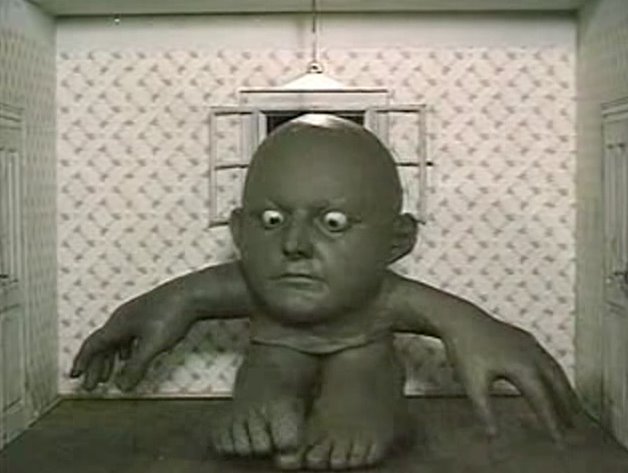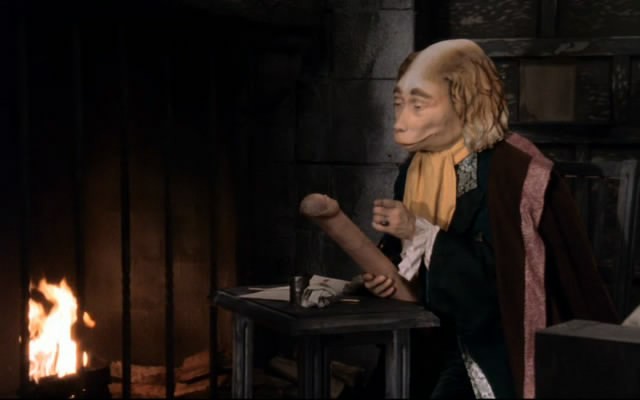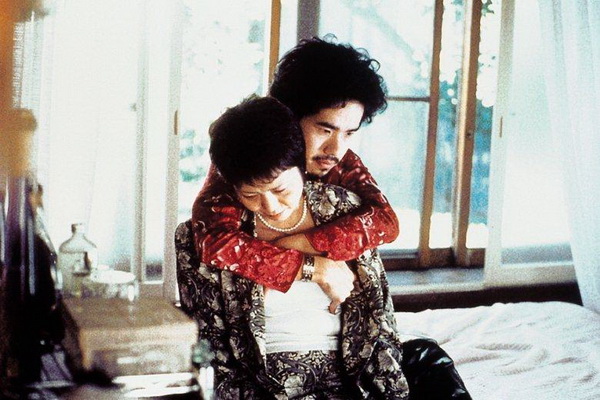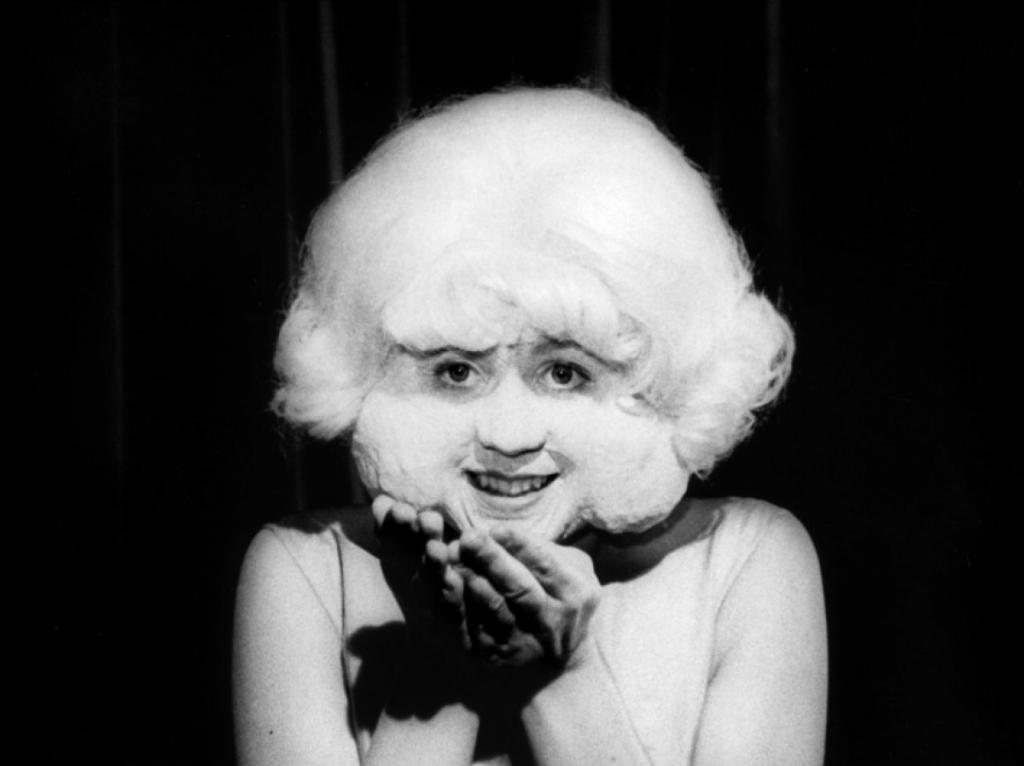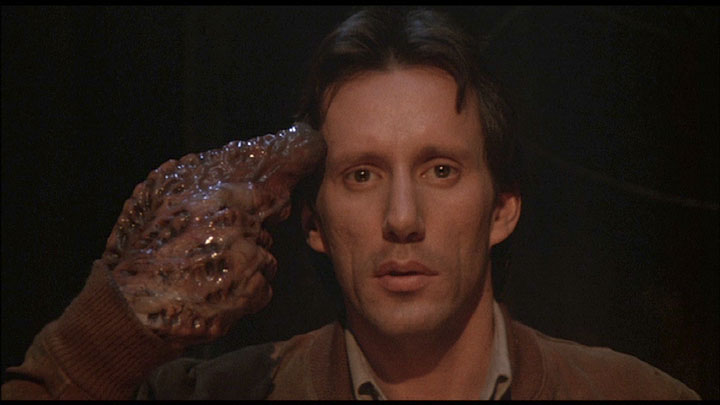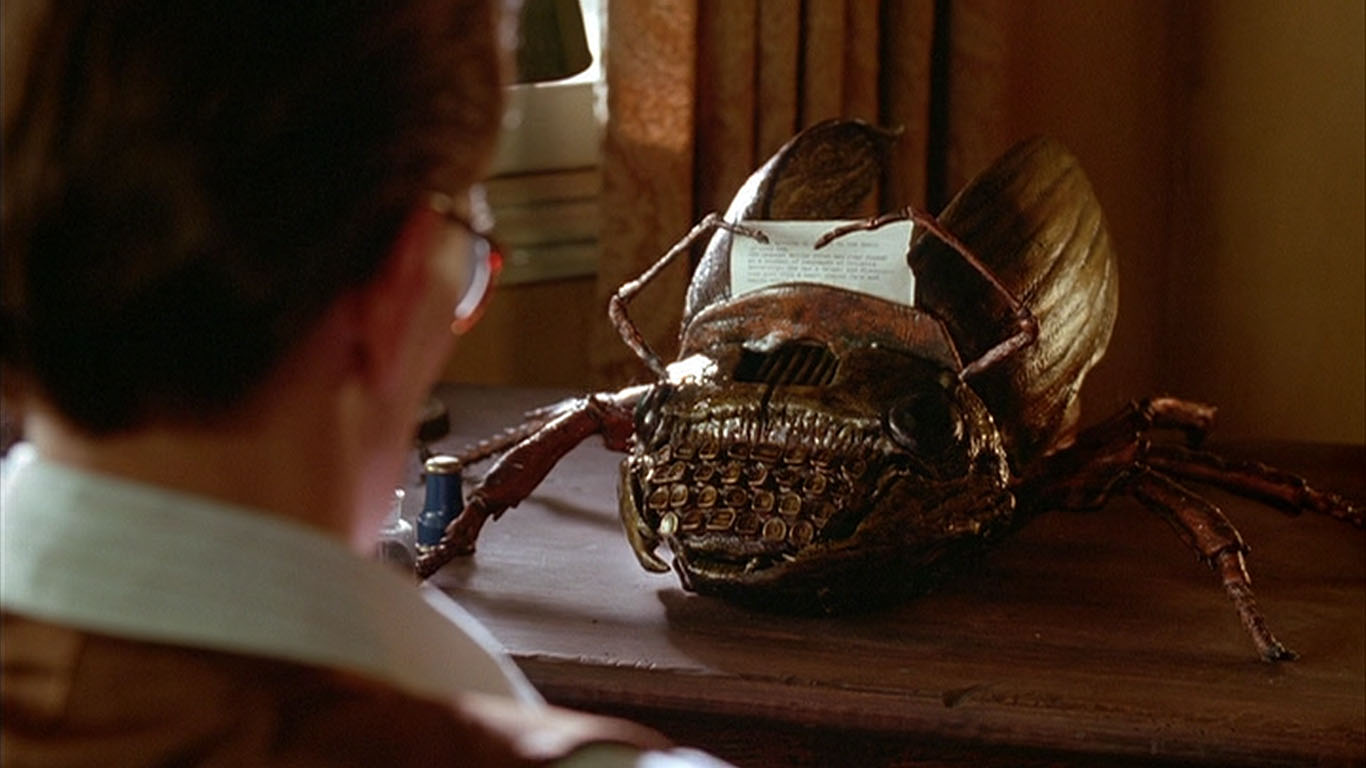Wolfgang Kayser stated that grotesque is a foreign intrusion in a world that seems natural. A feeling of estrangement, an uncanny reality in the image we see. It’s a mixture of strange, horrific, and comic. However, through the cineast’s humoristic expression of the undeniable existence of death and incompletion in our lives, this genre becomes something much more complex than the sum of its parts.
Grotesque lies within the paradox of that comic angle forced upon these tragic images. The films on this list all have this propensity for tension and absurdity, rooted in images that often gross out or shock the viewer by their ultimate “corporality”. The keyword here is metamorphosis: while seeing the film, we feel the character or the environment changing before our very eyes.
15. Darkness / Light / Darkness (1989)
The work of Jan Švankmajer, grand master of stop motion animation, widely gives the strange impression of something not being quite okay. Seeing inanimate objects like dolls, meat, or stuffed animals suddenly come to life isn’t a comfortable feeling. Adding to the natural reaction of discomfort, Švankmajer uses clay animation to create an uncanny world where the material strangely mixes with flesh.
Jan Švankmajer’s “Darkness / Light / Darkness” explores the possibility of a body’s self-construction. Animated in Claymation, it focuses on the body’s elasticity and its ability to be altered and modified. The film begins in a little room where two hands try to put together other body pieces knocking at the door or on the windows.
The clay skin is ripped and remodeled. Each part reaches a destination on its own, sometimes in perfect disorder (ears on the hands, eyes in the mouth, etc.). The use of clay rather than a more flesh-like medium alleviates the greatly disturbing result: the tongue arriving by itself and sliding to open the door.
Clay also ties in an idea of the de-sacralisation of the body. Being entirely made of clay, body parts are likely to be reordered like a dismembered doll. No place for the soul in Švankmajer’s short film; the body is only a body.
14. Satyricon (1969)
For his baroque take on Petronius’ “Satyricon”, Federico Fellini said he was attracted by the gaps between the original book’s episodes. This feeling of incompletion underlies Fellini’s film, which was also very episodic. His interpretation of this antique novel uses grotesque to recreate a dream-like world where everything seems off. The idea of satire transpires throughout the film: theatre, makeup and artifices, and people who are not what they claim to be all abound in the scenes of “Satyricon”.
The story follows the tribulations of young Encolpio on a journey to recover his slave and lover Gitone. Complex and epic, this Fellini piece depicts strong and weird characters, from the vulgar Trimalchio, a rich, freed slave holding hedonistic banquets, to the nymphomaniac woman who Encolpio must satisfy in the desert. Grotesque in “Satyricon” presents itself in the characters, painted with heavy makeup and dressed in costumes that casts them as a mere representation, a mockery of power.
As in the carnival-esque tradition, social roles are reversed; the slave becomes the master, poets are ridiculed and killed, and sex is life’s sole purpose. For example, when Encolpio loses his virility after being defeated by the Minotaur, he doesn’t know how to behave in society and instead seeks to recover it.
13. Marquis (1989)
The idea for “Marquis” originated in the mind of the French surrealist artist Roland Topor, also one of the main ideators of the Panic Movement (along with Jodorowsky and Arrabal). The core idea of the Panic artistic movement is one of a joyous shock, a carnival-esque take on reality where the actor, as Antonin Artaud states, isn’t hidden by a character but is simply himself, sharing an experience with the spectator.
The use of animatronics to play the different characters in “Marquis” may sound quite contradictory with that ideal, yet we still strongly feel the actors’ presence as their hands are seen playing with the elaborate masks.
The life and œuvre of Marquis de Sade, a revolutionary politician of the 1700s and author of well-known erotic literature, is loosely the inspiration for “Marquis”. By juxtaposing characters from the Marquis’ best-known books to extracts of his biography, the film is both homage and an exploration of the subversive animation’s possibilities.
To set an example, Marquis’ own penis is a recurring character named Colin, with whom he has several philosophical conversations. Equally disturbing are the torture scenes, where characters depicted as animals with human hands re-enact the sadistic scenes.
12. Visitor Q (2001)
Takashi Miike’s weirdest creation is this documentary-like tale of healing, where a dysfunctional family is transformed by the presence of a neutral being, Visitor Q. With an opening scene showing a young prostitute trying to convince her father to have sex with her, “Visitor Q” may at first seem more transgressive than grotesque. However, the arrival of the enigmatic Q in this already disturbed family slowly alters their way of life.
At first, the son hits his mother to express his frustration of being bullied at school, the mother is a regular heroin user and the father is obsessed with the idea of capturing images of youth violence for a documentary. After being knocked on the head by Visitor Q, the father weirdly invites him to live with them in their home.
The presence of a neutral and voyeuristic stranger in this little world eventually affects the characters. The mother rebels when her son tries to attack her again, and the father rapes and kills one of his coworkers as Visitor Q films the scene. Grotesque appears in the way the characters react joyously and without any moral issues ever since Q has entered their lives.
11. Eraserhead (1977)
David Lynch’s first feature film is a bizarre journey into a world where reality is perpetually distorted. The black and white movie tells the story of Henry Spencer (Jack Nance) trying to continue his routine in a world about to destroy itself. Coming back to his apartment with groceries, Spencer is told that he and his girlfriend are invited to dinner at his parents. During the evening, he learns that he is the father of a baby.
As it is often the case in Lynch’s movies, things are not what they seem to be: the chicken served for dinner starts to move and bleed, the baby is a strange alien-like creature, and the radiator in Spencer’s room is inhabited by a lady with bursting cheeks.
The feeling that nothing is quite real made this film one of the last successful and largely appreciated midnight movies. Even the surreal way in which Lynch plays with sound becomes an important part of the story (noise is the first reason why the mother leaves her alien baby to Henry Spencer).
Set in an industrial and quite apocalyptic world, “Eraserhead” is a film about confusion, guilt, and unspoken desires. In a very Kafkaesque manner, everything here is about an unsaid primary fault. Henry desperately tries to be forgiven until (literally) bursting into a new self and dives into a fantasy world where, as the young maiden is singing, “everything is fine”.
10. Videodrome (1983)
A grotesque anthology could not be complete without a David Cronenberg movie. One of the first masters of the body horror genre, Cronenberg uses the body of his characters as a medium, transforming them and playing with effects to create strong and visceral images. A famous example is “The Fly” (1986), where the main character is slowly becoming an insect, losing his skin, gaining new hair, and growing new horrific protuberances.
“Videodrome” is all about the idea of watching and being watched. Producer Max Renn (played by James Woods) is a well-known TV station manager who becomes obsessed with a TV show called Videodrome. Recorded on tape, it shows people being tortured and molested in a little room. In search of his next new sensational show, Renn tries to get in touch with the show’s creator.
With an increasing fascination for the cassette, he soon discovers the harsh reality behind it: what we see is not fictional, and watching the show produces a signal causing brain tumors in its spectators. Subject to hallucinations, he quickly becomes the magnetoscope, simultaneously watching and being watched.
The film is a bitter critic of the power of media in our daily lives, particularly regarding violence and sex. Literally sucked into the TV world, Max has no other option but to surrender himself to this “new flesh” he has grown.
9. Naked Lunch (1991)
The second film by Cronenberg on this list, “Naked Lunch” is a cinematic based on the same-name novel by William S. Burroughs. The complex work of Burroughs, until then considered impossible to adapt into a movie, serves as a backdrop to Cronenberg, who willingly complexifies the book’s already intricate story.
Inspired by both the novel and the life of Burroughs, “Naked Lunch” tells the story of William Lee, an exterminator who discovers his wife using his insecticide as a drug, and eventually starts using as well. During one terrible bad trip, a coackroach-tapewriting machine convinces Lee that his wife is part of a secret agency called Interzone. After accidently killing her, he is projected in a film noir world where he writes reports for an unknown handler.
The dark and hallucinogenic world of “Naked Lunch” is recognized as one of Cronenberg’s key achievements. The complex plot, inspired by Burroughs, allows the director to play on the grotesque, creating giant monsters in an infinite state of metamorphosis.
The creatures of Cronenberg, halfway between humanoïds and insects, crave sex in spite of their ugliness, and portray strong inversions of reality. As the intrigued but terrified Lee discovers by the end of the movie, insects become bigger than humans, with the ability to use them to satisfy their very desires.
Confusing yet fascinating, “Naked Lunch” is probably, along with “The Fly”, the most talked about of Cronenberg’s films, and surely the one that defines best his signature style.
